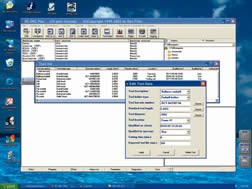A Simple Way To Implement A Qualified Tooling System
Shops often use a DNC system simply to transfer part program files to machine tools. While this certainly has its advantages, few shops use DNC in more advanced ways, such as a means of integrating a qualified (preset) tooling system to monitor tool life and speed setups.
Shops often use a DNC system simply to transfer part program files to machine tools. While this certainly has its advantages, few shops use DNC in more advanced ways, such as a means of integrating a qualified (preset) tooling system to monitor tool life and speed setups.
According to Dan Fritz, president of Suburban Machinery Software (Willoughby, Ohio), high cost and implementation difficulties are the primary reasons why shops don't adopt a qualified tooling system. The new tooling control system (TCS) option on the company's PC-DNC Plus software makes this as easy as scanning bar codes on inexpensive, disposable tags. TCS allows automatic loading of tool offsets into a machine's CNC during setup, in addition to monitoring tool usage and sending e-mail alerts when a tool has broken or is nearing its expected lifespan. The only additional hardware items required are bar code readers and pre-printed bar code tags and machine placards.
Here's how the system works: After a new tool or new inserts are installed in a toolholder, the tool's standard length and diameter are measured and entered into the system's database (this can be done automatically if the measuring devices have an RS-232 serial output). The system also records the technician's name, date and time the tool was qualified, as well as the expected tool life, if desired. Once a tool is qualified, a disposable bar-coded tag is attached to the toolholder, and that bar code is scanned to identify the tool in the database.
A placard attached to the machine contains bar codes representing the machine's tool carousel positions. When loading a qualified tool, the operator first scans the bar code on the tool's tag. Next, the tool position bar code on the machine's placard is scanned so the system knows which tool is located in that particular carousel position. The toolholder tag is then discarded. After all tools are loaded into the machine, the operator scans a bar code on the placard that signifies this, and the system automatically sends the temporary tool offset files to the CNC.
The system's database logs and displays the amount of time that each tool has been in use, in addition to showing all other data entered for the tool. When a tool approaches its expected cutting life, the system can be set up to automatically transmit pages or e-mail messages to alert shop personnel.
If a tool's useful life has been reached, then a new tool or inserts can be mounted and the tool is re-qualified and assigned a new bar-coded tag. If a tool that has not reached its cutting limit is removed from the machine, then that tool's accumulated cutting time can be carried over to the new tag that is assigned to the toolholder.

.jpg;width=70;height=70;mode=crop)












.png;maxWidth=300;quality=90)



